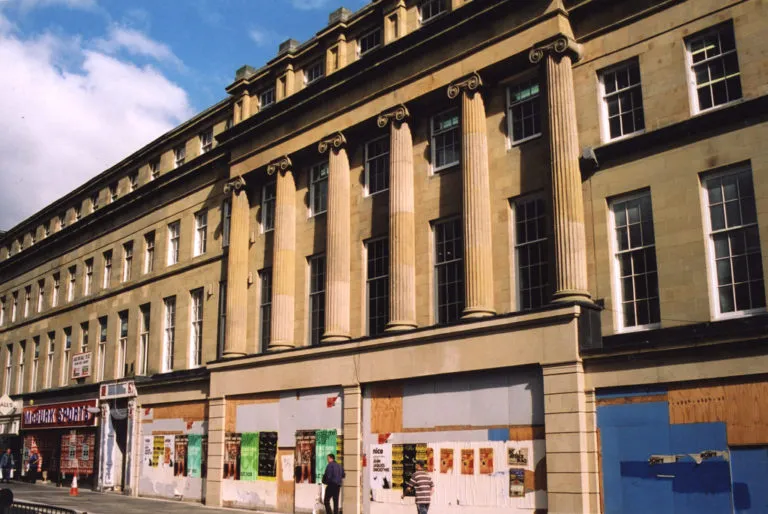Permitting shop to housing conversions – just more permitted slum-building?
Published: by John Bibby

If you’re paying close attention to news on a forthcoming ‘Great Recovery Bill’, you will have heard that the government plans to make it easier for shops to be converted into housing.
Details are scant, but it sounds suspiciously like a plan to extend existing ‘permitted development rights’ (PDR) to include more retail-to-residential conversions.
If it is, it could be real bad news.
Existing permitted development rights to convert offices to housing have exhibited the worst consequences of crummy deregulation. It’s led to new slum-like conditions and reduced contributions to new social housing, the type of housing we actually need.
Instead of turning a blind eye to bad development – and giving a huge payday to commercial landlords – we should use the Great Recovery Bill to build back better with a programme of new social homebuilding.
Permitted development rights – the background
‘Permitted development rights’ grant automatic planning permission for specific types of development. Originally, they applied to small changes that you might want to make to a single property, like building a small extension on your home.
For these small changes, they provide an exception to the normal requirement to go through the full planning process. This makes it easier for the developer; the trade-off is that what gets developed isn’t subject to the full scrutiny of the planning system.
But although permitted development rights started out small, in recent years the range of things you can do under them has grown. It now includes some pretty big changes. Since 2013 this has included converting whole offices into housing.
It appears that this may be extended in the ‘Great Recovery Bill’ so that it’s easier to convert more shops to housing under permitted development rights too, e.g. possibly shops of more than 150m2.
Permitted slum-building
What could be wrong with that? Well, too often in practice, allowing permitted development conversions from office to residential has effectively been turning a blind eye to the creation of places so horrible to live in they’ve been called new slums. There’s no good reason that converting more shops should be any different.
Terminus House, a former 1960s office block next to Harlow bus station, is the most famous example of bad office-to-residential conversion. Cramped, crummy, it was described by a resident of one of its 214 flats as a ‘human warehouse.’
But it is not the only nightmarish case.
Other office-to-residential conversions highlighted in this blog have had no windows (only skylights), been in isolated locations miles from a shop or public transport, or impossibly small.
There have been ‘double studios’ that start at 14.7m2, only marginally larger than the 10m2 recommended by the Association for the Prevention of Torture as the minimum size of a double prison cell.
A promised review into standards in permitted development conversions has still not been published and no update has been given. At the very least, this needs to happen before an extension is contemplated.
To rub salt in the wound, conversions under permitted development can’t be obliged to contribute to new affordable or social housing. Affordable housing contributions are attached to normal developments as part of the full planning process. But permitted development conversions avoid the full planning process, so they avoid the obligation.
Payday for commercial landlords
So, the potential downsides are clear, but what’s unclear is how much of a contribution towards getting the economy moving again new permitted development rights would make.
Struggling retailers and shops wouldn’t benefit. If anything, by cutting available retail space it could add pressure to rents. The main beneficiaries would likely be commercial landlords who would get a boost to the value of their property portfolios.
Even before the pandemic, changes in the way we all shop were cutting retail values and forcing commercial landlords to accept big losses. The lockdown has only added to the pressure, by cutting rental income as struggling shops refuse to pay.
Having the option of converting shop space to new housing without planning risk or contributing to new social housing gives commercial landlords a hedge against further falls in retail values.
It’s true that big changes to the high street will be needed because of our changing shopping habits. And no one is against converting the use of properties as a point of principle. But we must make sure that changes benefit local communities, not damage them.
Building back better
There are growing calls for the recovery to ‘build back better’. The prime minister himself has said that as we rebuild we must make a “fairer, greener and more resilient global economy.”
The thing about building back better is that it must be done intentionally. A government can’t just do away with the rules and hope for the best. At least not without serious consequences.
Permitted development is the embodiment of turning a blind eye and leaving what gets developed to chance. So far, the result has been the creation of new slum-like housing conditions.
What’s needed instead is a new direction. Building a new generation of decent, green social rent homes will stimulate the economy and spread the benefits of economic growth.
This is the direction we need the Great Recovery Bill to go. And it’s what the country needs to solve its continuing housing emergency.
Photograph by Newcastle Libraries.